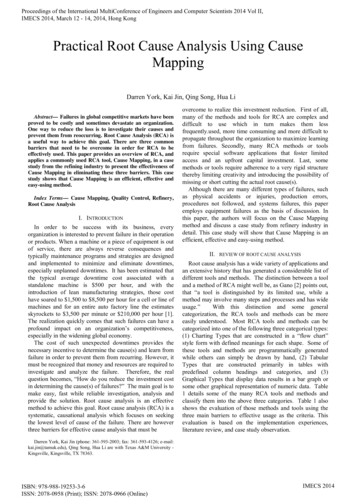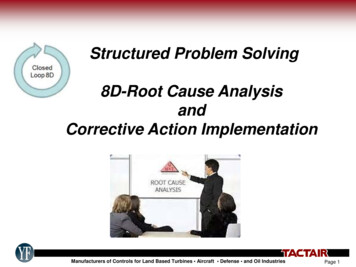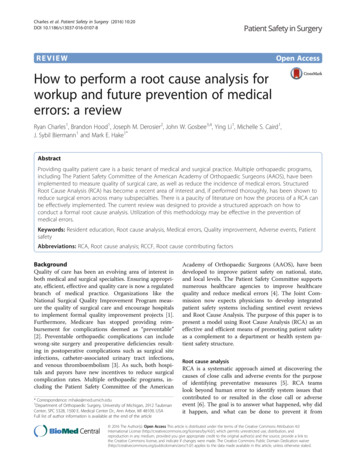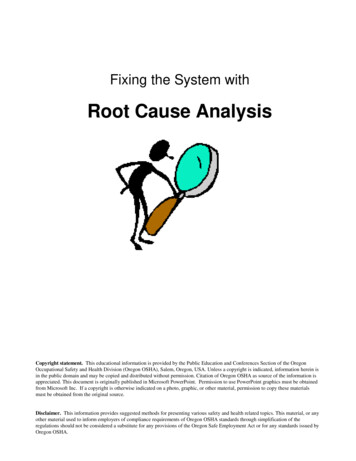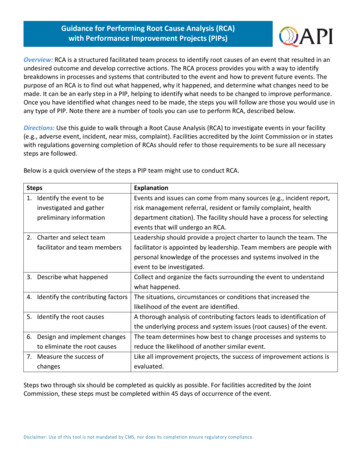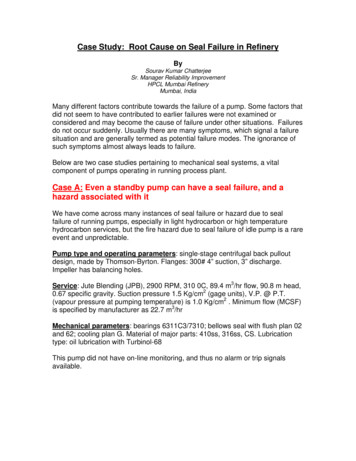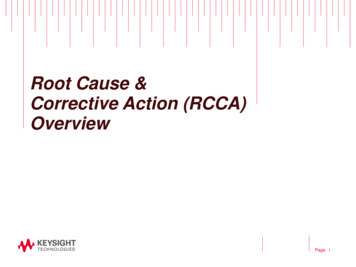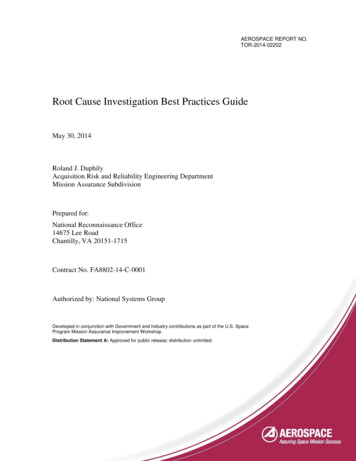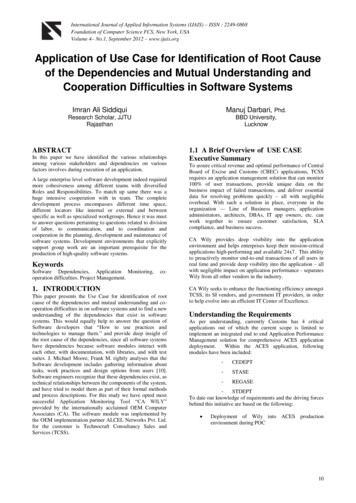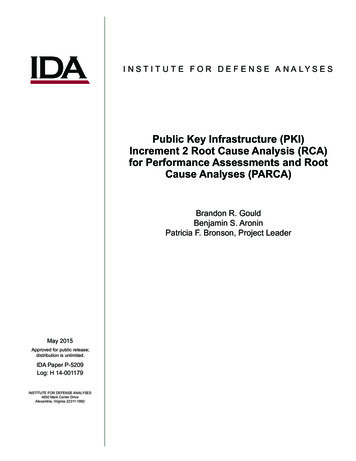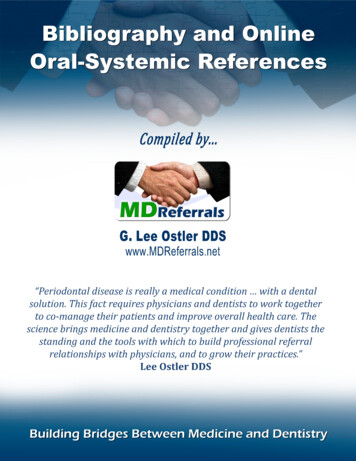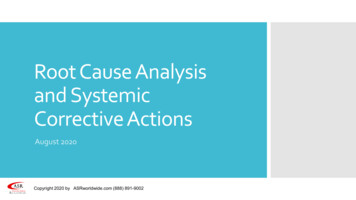
Transcription
Root Cause Analysisand SystemicCorrective ActionsAugust 2020Copyright 2020 by ASRworldwide.com (888) 891-9002
All ISO-based standards require defined steps to rectifynonconformances, including the following: Containment, interim actions and related activities necessary forcontrol of nonconforming outputsIntroduction Root cause analysis, methodology used, analysis and results; Implementation of systemic corrective actions, includingconsideration of the impact on similar processes and products; Verification of the effectiveness of implemented corrective actions Reviewing, and where necessary, updating the appropriatedocumented information (e.g. PFMEA, control plan, workinstructions, procedures, etc.)Copyright 2020 by ASRworldwide.com (888) 891-9002
Here are some important definitions:Definitions Correction: defined as “Action to eliminate a detectednonconformity” Corrective Action: defined as “Action to eliminate the systemiccause of a detected nonconformity”Copyright 2020 by ASRworldwide.com (888) 891-9002
Root cause analysis is a logic-based methodology to determinewhat, how and why an event or failure happened.Root Cause Effective root cause should Identify the specific underlying situations or eventsSomething(s) that can be reasonably identifiedBe fixable by Top ManagementIdentify something that can be prevented at a systemic levelCopyright 2020 by ASRworldwide.com (888) 891-9002
When we write a nonconformance, identifying the process thatfailed within the system helps drive efforts towards systemicanalysis and actions. If the nonconformance isn’t geared towards the process,corrective actions may not be systemic in nature.NonconformanceStatements Clear nonconformance statements are the first step. Citing the specific evidence found during the audit doesn’ttypically belong in the nonconformance statement; list that underthe evidence.Copyright 2020 by ASRworldwide.com (888) 891-9002
Three DistinctParts of an NC Let’s look at a couple of examples to show the 3 distinct parts of anonconformance: Nonconformance Statement Requirement EvidenceCopyright 2020 by ASRworldwide.com (888) 891-9002
Here are some Nonconformance Statement examples that couldbe reworded: Example 1: Work instructions #48A, #56C and #93F are all missinginformation. Better: The process to maintain work instructions is not effective.NonconformanceStatements Example 2: Preventive maintenance records are missing forMachine #582. Better: The maintenance process is not entirely effective. Example 3: The control plan and router for PN 23-5901485 havedifferent inspection frequencies for measuring O.D. grind. Better: The quality planning process is not effective in all areas.Copyright 2020 by ASRworldwide.com (888) 891-9002
Nonconformance Statement: The maintenance process is notentirely effective.Example Requirement: IATF 8.5.1.5, The organization shall develop,implement and maintain a documented total productionmaintenance system. At a minimum, the system shall include thefollowing h) use of preventive maintenance methods. Evidence: Preventive maintenance records are missing forMachine #582.Copyright 2020 by ASRworldwide.com (888) 891-9002
Nonconformance Statement: The quality planning process is noteffective in all areas.Example Requirement: ISO 9001, 8.5.1c: The organization shall implementproduction and service under controlled conditions. Controlledconditions shall include, as applicable: c) the implementation ofmonitoring and measurement activities and appropriate states toverify that criteria for control of processes or outputs.have beenmet. Evidence: The control plan and router for PN 23-5901485 havedifferent inspection frequencies for O.D. grind.Copyright 2020 by ASRworldwide.com (888) 891-9002
Process ASR does not dictate what methodology our customers use; wedo however, require them to submit the results of their analysisalong with the finalized root cause(s). This should be submitted along with the completed F-3000 NCRform, or their own corrective action form that contains the sameinformation.Copyright 2020 by ASRworldwide.com (888) 891-9002
F-3000 Nonconformance Report Customers may utilize their own corrective action format, as long asit contains all four required fields on page 2 of the ASR form F-3000: ProcessCorrectionRoot cause analysisCorrective actionVerification It’s helpful if they reference their form on our F-3000.Copyright 2020 by ASRworldwide.com (888) 891-9002
Corrective action submissions for all audits (except Stage 1)against all standards must include the following:Process F-3000 Nonconformance Report, or the customers equivalent Evidence of correction Root cause methodology and results, with a final root causestatement Corrective action plan that addresses the identified root cause Effectiveness verification showing the root cause has beeneliminated or mitigated Let’s review each of these items in more detail.Copyright 2020 by ASRworldwide.com (888) 891-9002
Correction Consider correction the “band-aid” or short term action toimmediately fix what was identified. Customers must submit evidence of correction when anonconformance is issued.Correction For example, if the auditor writes a nonconformance because there’s avital step missing from a work instruction, the correction would be toupdate the work instruction. If the auditor identifies that there’s a mismatch between twodocuments, the customer would update both documents with thecorrect information. Correction only fixes the symptom of theunderlying systemic issue.Copyright 2020 by ASRworldwide.com (888) 891-9002
Correction Depending on the severity of the nonconformance, correctionmay also require the containment of product in-house, sorting /inspection, rework / repair and notification to the customer.Copyright 2020 by ASRworldwide.com (888) 891-9002
Many companies shine when determining root cause for adefective part, but struggle with performing it for a process.Root CauseAnalysis Solid root cause analysis can be painful as the truth becomesapparent. No one wants to admit there was a failure in theirsystem, or there was something they “forgot” as part of theplanning process. There are several methods available to help identify what wentwrong, why it occurred and/or what allowed the situation to exist. For all standards, ASR requires the customers to submit their rootcause analysis, methodology and results (See F-3000 NCR Form).Copyright 2020 by ASRworldwide.com (888) 891-9002
Root Cause AnalysisRoot CauseAnalysis This is the most important step in the corrective action processbecause when done properly, it identifies the gap in the system toprevent recurrence. Root cause analysis and methodologies might include (but are notlimited to):Copyright 2020 by ASRworldwide.com (888) 891-9002 5-WhyFishbone DiagramIs/Is NotBrainstormingPareto chartFlowcharting
Root Cause Analysis should answer the questions “why,” “how”and “what”Root CauseAnalysis Why did / didn’t that happen?How did that happen?Why wasn’t it detected?What would stop it from happening again?Copyright 2020 by ASRworldwide.com (888) 891-9002
Going back to an earlier example of a work instruction missing avital step, review the following examples of root cause and seewhich ones you think are valid: Nonconformance Statement, written at the system level: Theprocess to maintain work instructions is not effective in all areas.Root CauseAnalysis Possible Root Causes: 1. The work instruction didn’t contain all the steps.2. The employee responsible didn’t understand the requirements.3. The operators didn’t tell us it was wrong.4. The prior process engineer wrote it but he has since been fired.5. We forgot to include it.Copyright 2020 by ASRworldwide.com (888) 891-9002
Did you think any of these were valid? Did any of these statementsaddress the failure at a systemic level?Root CauseAnalysis The answer is no! Let’s review each one with a bit more discussion.Copyright 2020 by ASRworldwide.com (888) 891-9002
1. The work instruction didn’t contain all the steps. This is merely a restatement of the nonconformance statement. 2. The employee responsible didn’t understand the requirements. This might be a starting point, but the next question should be “why” –why didn’t the employee understand the requirements? This may leadto additional questions related to training / training effectiveness,documentation of job responsibilities and definition of competencyrequirements.Root CauseAnalysis 3. The operators didn’t tell us it was wrong. Blaming the employee is invalid 99.9% of the time, unless there isevidence of blatant disregard or deliberate tampering. 4. The prior process engineer wrote it but he has since been fired. Blaming an individual doesn’t identify the systemic gap. 5. We forgot to include it. On a very rare occasion, this might be a valid statement, but only ifthere is evidence that everything else was reviewed and rejected as apotential contributor to the situation.Copyright 2020 by ASRworldwide.com (888) 891-9002
Many customers us the 5-Why methodology to analyze potentialgaps in a process. This method starts with thenonconformance statement,then keeps asking “why” withRoot CauseAnalysiseach answer until the systemicfailure is identified. The underlying root cause has been reached when the final whysatisfies the following criteria: It initiates and causes the event we are seeking to explain. It is directly controllable. The elimination of that root cause will result in the elimination orreduction of the problem.Copyright 2020 by ASRworldwide.com (888) 891-9002
Let’s look at a few more examples of unacceptable root causestatements and additional questions that could be asked asstarting points for a 5-Why: The machine malfunctioned.Root CauseAnalysis This doesn’t answer the question of “why” the equipmentmalfunctioned. What caused the machine to stop working correctly?Was it a preventable situation? Has the machine ever malfunctionedthat way before? If so, why? Our previous auditor didn’t find it. Blaming the auditor for not identifying doesn’t answer the questions of“why” the situation existed! It was done by a new employee Was the employee trained? If not, that’s a good starting point: Whywasn’t the employee trained? If so, was that training verified aseffective? If not, there’s another starting point: Why wasn’t theeffectiveness of training verified?Copyright 2020 by ASRworldwide.com (888) 891-9002
Let’s look at a simple example of a 5-Why analysis for thatnonconformance statement: The process to maintain workinstructions is not effective in all areas. Why? Posted work instruction is missing a critical step. Why? Step was added to the process as a result of a continualimprovement.Root CauseAnalysis Why wasn’t the work instruction updated? The quality engineerimplemented the change using an approved internal deviation. When thedeviation expired, the work instruction was never updated to permanentlyimplement the change. Why wasn’t the work instruction updated? No formal requirement inthe change control process to trigger a review for possible documentupdates from approved internal deviations. Now we have a root cause that is actionable at the system level!Copyright 2020 by ASRworldwide.com (888) 891-9002
Corrective ActionCorrectiveAction The purpose of corrective action is to prevent recurrence byupdating the system in some way. It’s uncommon for the corrective action be identical to thecorrection taken to fix the immediate issue. In our work instruction example, we identified the following rootcause: No formal requirement in the change control process toreview for possible document updates from approved internaldeviations. This sounds like updates are required to their change controlprocess. This might include a procedure, process flow, checklist, turtle, workinstructions, job responsibilities or other system level documents toeffectively implement that change.Copyright 2020 by ASRworldwide.com (888) 891-9002
CorrectiveAction When reviewing corrective action plans and evidence ofimplementation, be sure that the actions actually address theidentified root cause. For example, if the root cause states “There is no formal processto validate tools” the corrective actions should include somethingabout tool validation, e.g. a new or updated Buy-Off procedure, achange to the APQP process or Launch form, something like that.Copyright 2020 by ASRworldwide.com (888) 891-9002
CorrectiveAction Impact Corrective Action Impact The customer’s corrective action should include an assessment ofsimilar parts and/or processes to ensure that the same symptomthat was identified as part of the original nonconformance doesn’texist elsewhere in the system. Some people call this a “read–across”Copyright 2020 by ASRworldwide.com (888) 891-9002
VerificationVerification Once the customer has implemented their systemic action plans,they need to verify the effectiveness of their actions. This doesn’t mean verification that the actions were taken! This means they have monitored the situation to determine that theactions they took have truly prevented recurrence. This might involve a special internal audit, an update to their layeredprocess audits or monitoring of data that demonstrates the systemchanges will prevent the situation from occurring again. In some cases, the customer may realize their actions were not farreaching enough and revise their action plans.Copyright 2020 by ASRworldwide.com (888) 891-9002
Once the customer has submitted their corrective actions, theauditor will evaluate the following:ReviewingCorrectiveActions Is there evidence of correction? Was correction applied to similarsituations? Does the root cause apply to the system and not just the specificevidence c
Corrective Action Corrective Action The purpose of corrective action is to prevent recurrence by updating the system in some way. It’s uncommon for the corrective action be identical to the correction taken to fix the immediate issue. In our work instruction example, we identified the following root
